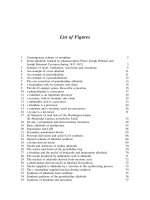- Trang chủ >>
- Khoa Học Tự Nhiên >>
- Vật lý
nanotechnology applications and markets
Bạn đang xem bản rút gọn của tài liệu. Xem và tải ngay bản đầy đủ của tài liệu tại đây (1.29 MB, 241 trang )
Nanotechnology Applications
and Markets
For a complete listing of the Artech House Nanotechnology Library,
turn to the back of this book.
Nanotechnology Applications
and Markets
Lawrence Gasman
a
r
tec
hh
ouse
.
co
m
Library of Congress Cataloging-in-Publication Data
A catalog record of this book is available from the U.S. Library of Congress.
British Library Cataloguing in Publication Data
Gasman, Lawrence
Nanotechnology applications and markets.—(Artech House nanotechnology library)
1. Nanostructured materials industry 2. Nanotechnology
I. Title
338.4’76205
ISBN 10: 1-59693-006-3
ISBN 13: 978-1-59693-006-3
Cover design by Yekaterina Ratner
© 2006 ARTECH HOUSE, INC.
685 Canton Street
Norwood, MA 02062
All rights reserved. Printed and bound in the United States of America. No part of this book may
be reproduced or utilized in any form or by any means, electronic or mechanical, including pho-
tocopying, recording, or by any information storage and retrieval system, without permission in
writing from the publisher.
All terms mentioned in this book that are known to be trademarks or service marks have been
appropriately capitalized. Artech House cannot attest to the accuracy of this information. Use of
a term in this book should not be regarded as affecting the validity of any trademark or service
mark.
International Standard Book Number: 1-59693-006-3
10 9 8 7 6 5 4 3 2 1
To the victims of high-tech bubbles everywhere and everywhen and to Cynthia,
my inspiration
Contents
Preface
xiii
1 Nanotechnology: An Overview 1
Disputes and Definitions: What Is Nanotechnology? 1
A Very Brief Guide to the Science Behind Nanotech:
Why 100 Nanometers? 2
The Early History of Nanotech 7
Eric Drexler’s View of Nanotech as Molecular
Manufacturing 9
Nanotech as the Evolution of Chemical Engineering 11
Nanotools and Nanomanufacturing 11
Summary: Key Takeaways from This Chapter 21
Further Reading 22
2 The Business of Nanotech 25
Introduction: The Hidden Assumption of Nanobusiness 25
Three Scenarios for the Nanotechnology Industry 27
vii
Nanomaterials and Nanodevices 36
A Word or Two About MEMS 43
Four Types of Nanotech Business Opportunities 45
The Importance of IP in Nanotech 48
The National Nanotechnology Initiative and
Other Government Nanotech Programs 51
Funding Issues for Nanotech Businesses and Projects 59
Nanotech, Safety, and the Environment:
Nanotech’s Little PR Problem 62
Summary: Key Takeaways from This Chapter 68
Further Reading 70
Nanotech in the Semiconductor, Computing, and
3 Communications Industry 71
Introduction: Nanotech and Moore’s Law 71
When Moore’s Law Fails 72
Nanotubes, Nanowires, Nanoelectronics 76
Notes on Nanowires 84
Spin and Nanoelectronics 85
Nanoelectronics with Molecules 86
Just One Word, “Plastics” 88
On Quantum Dots 96
Nanophotonics 97
Summary: Key Takeaways from This Chapter 98
Further Reading 99
4 Nanotech and Energy 101
Introduction: The Real Energy Crisis 101
viii
Nanotechnology Applications and Markets
Economic Analysis of the Opportunities for
Nanoenergy Firms 103
The Impact of Nanotechnology on the Energy Sector 105
The Nano-Enhancement of Fossil Fuels 106
Nanotech, the Environment, and the Road to the
Hydrogen Economy 111
Nano-Solar Power 115
The Nano-Enhanced Distributed Electricity Grid
of the Future 118
Nano Power for the Pervasive Network 119
Summary: Key Takeaways from This Chapter 121
Further Reading 124
5 Nanotech, Medicine, and the Pharmaceutical Industry 127
A Nanotech Paradox 127
Timescapes 128
The Tipping Point 130
Seven Ways Nanoengineering Will Contribute to
Nano-Enabled Drug Discovery 131
Six Ways That Nanotechnology Will Contribute to
Drug Delivery 136
Nanotechnology and Medical Diagnostics 139
Nanotechnology and Regenerative Medicine 142
Timeframes, Futuristic Nanomedicine, and
a Business Perspective on “Transhumanism” 145
Summary: Key Takeaways from This Chapter 147
Further Reading 148
Contents
ix
Spreading Nanotech: Industry-Specific
6 Opportunities and Future Opportunities 151
The Coming of the Nano Economy 151
From Chemical Industry to Nanomaterials Industry 152
Nanotextiles and “Intelligent Clothing” 154
Building Nanotechnology 161
Nanotech, Food, and Agriculture: A “Nanolithic”
Revolution 164
Planes, Trains, and Nanotechnology:
Too Many “Opportunities”? 166
Nanotech and Robotics 167
Summary: Key Takeaways from This Chapter 171
Further Reading 172
How to Conduct a Nanotech Implications Audit
7 in Your Company 175
Why an Audit? 175
The Nanotechnology Impact Analysis in Summary:
A Six-Step Program 177
Establishing Objectives 177
Fact and Trend Selection 178
Establishing a Data Collection Methodology 180
Opportunity Analysis 182
Threat Analysis 185
Organizational Analysis 186
Summary: Key Takeaways from This Chapter 187
Further Reading 187
x
Nanotechnology Applications and Markets
Appendix: Eleven Essential Information
Sources for Nanobusiness 189
A.1 The Diamond Age 190
A.2 The Singularity Is Near 191
A.3 Nanotechnology: Basic science and
A.3 Emerging Technologies 192
A.4 Nanotechnology.com 192
A.5 Nanotechweb.org 193
A.6 NanoMarkets 193
A.7 Nanoinfo.jp 194
A.8 The Foresight Nanotech Institute 194
A.9 Seeing What’s Next: Using the Theories of
A.9 Innovation to Predict Industry Change 195
A.10 Nanotechnology Law and Business 195
A.11 Nano-Hype: The Truth Behind the
A.11 Nanotechnology Buzz 196
Endnotes 197
About the Author 205
Index 207
Contents
xi
Preface
How very small the very great are.
—William Makepeace Thackeray
Small matters win great commendation.
—Francis Bacon
Nanotechnology is, broadly speaking, an emerging technology that enables
engineers to design and build new materials and products at the molecular level.
The impact of nanotechnology is already being felt in the form of new computer
memories that provide rapid access to stored data, that can hold more of this
data than the minidrives used in iPODs and do not need any external power
source to retain the data. It is being felt in the form of prototypes for photovol
-
taic cells that can literally be sprayed onto buildings or computers to provide
cheap power sources. And it is being felt in the form of “nanoengineered” gels
that speed the recovery of damaged nerve cells.
Not surprisingly, a technology this powerful is attracting attention. The
Economist, BusinessWeek, and Red Herring (a magazine for venture capitalists)
have all run cover stories or special reports on nanotechnology. New books on
nanotechnology and the underlying nanoscience are also appearing at an acceler
-
ating pace. However, much of the coverage of the business aspects of
nanotechnology in publications to date has been superficial at best. Most of the
articles on nanotech that have appeared in the general business press have been
written by journalists who do not specialize in this area, and therefore, the arti
-
cles have consisted of a few generalizations and anecdotes with little or no
xiii
serious attempts to point out where the opportunities in nanotechnology can
actually be found. Furthermore, most of the books published to date are more
about science and technology than economics.
All this is quite understandable. What is less understandable is that much
of the coverage of nanotechnology business has a strong tendency to be either
somewhat manic or somewhat depressive in nature. For instance, there are many
articles that proclaim that nanotechnology will lead to the biggest economic
boom since the rise of the microprocessor. These cite all the interesting work
that is being done in this field and the major firms and adventurous start-ups
that are involved. However, there are also many more articles that make the
quite legitimate point that it is all too easy to overestimate the impact of
nanotechnology and that most of the more spectacular expected products of the
nanotech revolution lie two to ten years away, if not further.
In this environment, it seems that there is room for a book optimistic
enough to characterize nanotechnology as a major upcoming business opportu-
nity and realistic enough to recognize that it would take time to build businesses
and develop products. Above all, a book that spent some effort going into the
specifics as to the opportunities that nanotech brought, how long these opportu-
nities were likely to take to develop, and outlined the appropriate business mod-
els necessary to make a profit from these opportunities. This book intends to
provide this information.
However, this book is also a product of disaster and of lengthy memories.
The “disaster” in question was the fall of the telecommunications industry
in the earliest part of this decade, which led me to refocus my research interests
on nanotech. The “lengthy memories” were those of the management of Artech
House, especially Mark Walsh. Mark commissioned a similar book from me on
the telecom industry in 1986 and then, in 2004, asked me to write this one. I
am looking forward to hearing from Mark again in 2022 with regard to writing
a business-oriented book on picotechnology or even femtotechnology. Since I
am currently in my fifties, I am not anticipating that Mark will call me once
more in 2040, but if some of the more ambitious advocates of nanomedicine are
to be believed that may indeed occur.
On Nanotech as an Epoch-Making Technology
There always seems to be a technology that defines the spirit of the times. I will
call these “epoch-making technologies.” If its strongest proponents are to be
believed, nanotechnology is the next such technology.
At one time or another epoch-making technologies have included farming,
the steam engine, electricity, automobiles, personal computing, and most
xiv
Nanotechnology Applications and Markets
recently, telecommunications. These technologies actually define society for a
while, as, for example, when we refer to the “information age,” or the “age of
steam.” These are the technologies on which the best engineers stake their careers
and where the smartest businessmen put their money and entrepreneurial ener
-
gies. Unfortunately, it is impossible to know for sure in advance whether a tech
-
nology is really an epoch-making technology. When I was a teenager, there were
few who would have argued against the notions that we would soon have electric
-
ity that was too cheap to meter as the result of atomic energy and that by early
twenty-first century space travel would be as common as air travel. But somehow
the space age and the atomic age have never actually occurred, at least not yet.
My guess is that many of you reading this book are doing so in the belief
that (pun intended) nanotech is the next big thing, or, in other words, that
nanotechnology is on the verge of becoming an epoch-making technology. If so,
the examples of the space and atomic ages should serve as cautionary tales.
Nonetheless, the not-so-hidden assumption behind the writing of this book is
that, at the very least, nanotech is going to be behind the next surge in high-tech
driven growth. It will not be too difficult to conclude from the chapters that fol-
low that one of my motivations for writing this book is that I really do believe
that nanotechnology will become an epoch-defining technology. This begs the
question of why I believe this.
I think that there are essentially two answers to this question:
Nanotech Brings New Power
The first of these answers is that, just as the wheel,
the steam engine, and the computer did earlier, nanotechnology gives us a
power previously unexperienced, that is, the power to consistently manipulate
matter at the molecular or even the atomic level. As discussed in later chapters,
we have always had this power to some extent, but the new tools that have
emerged as a commercial reality in the last couple of years have raised our abili
-
ties in this regard by orders or magnitude (see Chapter 1). As a result, we are
now in a position to create new materials, structures and devices to a degree
never before possible. We are a very long way from the somewhat God-like pow
-
ers that Eric Drexler talked about in the mid-1980s in his classic Engines of Cre
-
ation, the book that first popularized the notions of nanotech. It is possible that
we will never get to the stage that Drexler describes in his book, but it seems
nearly certain that we will make it most of the way.
Nanotech Is in Tune with Today’s “Megatrends”
Nanotech is certainly not the
only candidate for the next epoch-making technology. However, most of the
other candidates seem to need nanotechnology to reach their full potential. For
this reason, nanotechnology should be thought of as an enabling technology that
Preface
xv
in some way encompasses most of the other potential epoch-making technolo
-
gies. This fact may confer on nanotech the status of a sort of “supermegatrend,”
and more reason to think of it as an epoch-making technology than the individ
-
ual technology trends that it enables.
The role of nanotechnology as a broad-ranging, enabling technology is
taken up again in Chapter 2, but it is also worth examining here, because it is so
crucial to why many of us see nanotech as such a big business opportunity.
Mobile Communications
Mobile communications is being touted by firms such
as IBM, Intel, and Motorola as the next big thing in communications. These
firms expect a major transition over the next decade to an environment variously
called ubiquitous computing, pervasive computing, or invisible computing. In
this brave new world of ultimate mobility, we will all carry multifunctional mo
-
bile computing/communications/entertainment devices that will be always on,
taking in data from the Internet, sensor and RFID networks, and a plethora of
other sources. Wired communications will remain in place for telecom infra-
structure only, and wireless will be used for everything else. Mobile communica-
tions using the latest smartphones and notebook computers will transform the
way that business is done and personal relationships are conducted.
According to Motorola, the most important limitation on the rise of ubiq-
uitous computing is power. The current generation of lithium ion batteries
work just fine for a cell phone used for the occasional short phone call. How-
ever, if used to power future smartphones, such a battery is likely to run down
quite quickly. Nanotechnology comes into the picture here in a number of ways.
It will help enable new kinds of power sources, such as better batteries, minia
-
ture fuel cells, and tiny photovoltaic panels, that will have greater power densi
-
ties than today’s batteries. It will also enable more energy efficient components
and subassemblies for mobile devices. For example, a new generation of thin-
film transistors built using organic molecules are enabling low-power plastic dis
-
plays. Displays are typically the most power consuming subsystem in mobile
computing or communications equipment. In addition to saving power,
nanotechnology has the potential for bringing down the cost of mobile termi
-
nals and increasing the quality of visual output from these terminals.
Novel Energy Technologies
With oil at record prices per barrel, with both India
and China greatly increasing their consumption of oil, and the expectation that
the West will grow even more dependent on OPEC for its existence, improved
energy technology seems likely to be a focus of investment in the coming de
-
cade. This could mean technologies that improve the cost of production or the
efficiency of use of fossil fuels. Or it could mean alternative energy sources, such
xvi
Nanotechnology Applications and Markets
as solar power, wind power, biomass, and the like. Either way, the energy indus
-
try and energy consumption patterns are likely to be quite different in 2025
than they are in 2005.
Nobody is expecting nanotechnology to provide a wholesale replacement
for fossil fuels any time soon. However, what nanotech does promise are ways to
make fossil fuels go further and to extract them more efficiently. Nanoengineered
catalysts can be used to better extract oil, or turn oil into fuel for cars. At the
same time, nanoengineering is leading to better fuel cells and photovoltaics,
pushing these otherwise rather marginal alternative energy sources into new and
bigger markets. Most dramatically, nanotech has the potential to create new ways
to store and transport energy, which, in turn, will enable entirely new architec
-
tures for the power grid. In general terms, nanotechnology holds out the prospect
of radically arranging the economics of bringing power to the right place at the
right time.
Biomedicine and Pharmaceuticals
If you want to bet on a sure thing, then a
dramatic increase in demand for biomedical and healthcare products is what you
ought to be betting on. Right now, the youngest baby boomers are in their
forties and the oldest ones have just reached their sixtieth birthdays. The un-
comfortable truth is that all of them are going to need more health care quite
soon. It is not just the shear volume of boomers that will create this new de-
mand, it is their expectations that old age will be both comfortable and unusu-
ally long-lived that will accelerate the demand for products in the health care
and life sciences. This attitude is summed up in the subtitle of the very
nanotech-oriented life extension book coauthored by the inventor and futurist
Raymond Kurzweil, Fantastic Voyage: Live Long Enough to Live Forever .
1
Nanotechnology is having an impact on numerous aspects of biomedicine
and pharmaceuticals. In the pharmaceutical industry it is enabling drugs both
to be discovered and to be delivered more effectively. Increasing the likelihood
that new drugs will be discovered is inherently important to the pharmaceutical
industry, which famously relies on “blockbuster drugs” for its existence. How
-
ever, this is happening at a time when the ability of the industry to generate
such blockbuster drugs appears to be on the wane. The potential importance of
nanoengineered drug delivery systems can be easily understood by the apparent
ability of nanoengineering to replace chemotherapy with an injection of spe
-
cially prepared nanoparticles that kill cancer cells with minimal side effects for
the patient. Nanotech is also improving medical imaging with improved diag
-
nostic imaging techniques. Regenerative medicine is benefiting from gels that
provide structure for nerve cells to grow back after injury, including improved
stents for heart patients and even artificial blood cells.
Preface
xvii
Ubiquitous computing, a transformation of the economics of energy, and
radically new pharmaceutical and regenerative medicine technology will all be
epoch-defining in their way. What makes nanotech unique though is that it is
an enabling technology that will make possible some of the most important
developments in all of these areas.
A Cautionary Tale
As I shall discuss more in coming chapters, nanotechnology has much to do
with a growing revolution in materials technology and, as such, it should be no
surprise that it is an epoch-making technology in the manner defined earlier.
After all, many of the great epochs of human history have been defined in terms
of materials, such as stone and bronze, thousands of years ago, and more
recently, steel and silicon. The silicon revolution, of course, was all about the
ability of engineers to exploit the semiconductive properties of silicon to build
microprocessors, computer memories, and other devices. This led directly to the
most recent epoch-making technology that has generated important new
business revenues: telecommunications.
Telecommunications
2
became the epoch-defining technology of the 1990s
for a number of reasons, but primarily because an entirely new worldwide net-
working infrastructure had to be built to support the Internet. This infrastruc-
ture was digital, data-centric and, above all, optical and it replaced the old
analog voice-centric—(and mostly copper)—network. During the period that
telecom was in the ascendant, it was where the big money was to be made,
whether you were a stock market investor, businessperson, or engineer. Individ
-
ual investors rushed to get their money into the latest telecom IPO. Entrepre
-
neurs and CEOs did all they could to promote their businesses as being telecom
businesses. (Carl Russo, the head of Cisco’s optical telecom business unit at the
time, joked that if someone had opened “The Optical Bagel Store,” he would
have been mobbed by venture capitalists anxious to invest money.) Fiber-optics
engineers who left college with the expectations of modest salaries in academe or
some large industrial lab suddenly found themselves with more job offers than
they could handle, many of them fully equipped with stock options potentially
worth millions.
Within a few years, the telecom boom turned to bust as the digitalization
of the network infrastructure (which had actually begun in the 1970s, but
which went into overdrive with the arrival of the Internet) came to an end, as
did the first rush of headlong growth from the Internet. The telecom industry
went into a severe recession from which it is just now slowly recovering. In the
xviii
Nanotechnology Applications and Markets
process, the high-paying jobs and stock options all went away and fortunes
were destroyed. Nonetheless, becoming part of an epoch-making technology
wave has been rewarding for some. Many of the fortunes built during the
telecom go-go years were invested wisely and preserved. While many of the
upstart firms that appeared to take advantage of newly emergent opportunities
in telecom have gone the way of all flesh, others have survived and are even
beginning to flourish as the telecom industry bust gives way to telecom indus
-
try maturity.
The telecom experience should be a cautionary tale to anyone thinking of
becoming involved with a nanotechnology business, whether that business is a
group within a major corporation or a more entrepreneurial effort. There is a
message here for investors, too. The three biggest lessons that to be learned from
what happened to telecom are the following:
•
It doesn’t take an avalanche. The telecommunications industry provided
profitable opportunities for firms for over 100 years before the telecom
revolution. So even if nanotech turns out to be something less than an
epoch-defining, nanotech may still be responsible for creating new busi-
nesses, both large and small.
•
All good things come to an end. Everyone knew that the extraordinary
growth that characterized telecom in the late 1990s would come to an
end some day. (Though few believed the industry would crash so spec-
tacularly.) It would not be the greatest surprise if, at some time in the
next few years, nanotech also went through a similar boom-bust cycle.
It is easy to imagine, how, for example, a high-profile IPO could spawn
a nanotech boom.
3
In such a boom, many firms can be expected to
overreach in terms of both their product offerings and their revenue
expectations. In the telecom boom, several firms expected to build busi
-
nesses with billion dollar revenues with huge optical switching prod
-
ucts. In actual fact, the market demand for such switches never changed
much during the boom and neither did the size of switches required. If
a nanotech boom occurs, it will be important for nanotech businesses not to
be swayed by the hype and keep a firm grasp of market realities to build sus
-
tainable businesses. Almost all of the telecom boom era optical switching
firms have now disappeared.
•
Some things endure. As I have already noted, there are firms that came
out of the telecom mess fairly intact. In some cases, this is merely
because they were large firms with an established base of even larger
customers. However, some thought through the benefits of their
Preface
xix
products and could present their stories to customers in a convincing
way. The survivors’ marketing stories have typically had to do primarily
with reduction of capital and operational costs rather than the latest
networking technology. It will behoove emerging nanotech firms to focus
on relatively easy-to-prove cost-related benefits than on the gee-whiz features
of a revolutionary technology.
On the Other Hand—Reasons for Nano Optimism
The experience of the telecommunications industry over the past few years pro
-
vides plenty of reasons for nanotech firms to be quite cautious in their product
and marketing strategies. Even if nanotechnology eventually turns out to be an
epoch-making technology in the way defined earlier, the best that can probably
be hoped for is that the nanotech epoch will last for a decade. In the course of
history, technology defined epochs have tended to last for shorter and shorter
periods. When nanotech gives way to something else, managers and engineers
who had previously believed that they had high-flying careers at booming
nanotech firms, and investors who saw their fortunes being made in nanotech,
will suddenly find themselves a lot poorer or even unemployed, as we have seen
happen in the telecom industry over the past few years.
However, the telecom analogy can also be taken too far. For one thing,
many of the new products that appeared during the telecom boom era seemed to
be way out of line with what the customers actually needed. The example of
optical switches has already been given. It is probably too early to be sure of the
general product directions of nanotechnology firms, but the fact that their prod
-
ucts are so well tied in to the needs of some leading industry sector trends
(enhanced mobile communications, better healthcare in an aging society, and
lower energy costs, for example) is certainly a reason for optimism about the
commercial future of nanotech.
This is a good argument to bring up to counter the comments of nano-
naysayers. For, although there is plenty of hype about nanotech, there is also
plenty of skepticism. This is healthy up to a point, as some of the pain of the
telecom bust might have been avoided if there had been more thoughtful criti
-
cism during the boom. However, in my opinion, the high-tech bust of the earli
-
est part of this decade and the related drop in equity values have now created a
pessimist attitude in some quarters about all new technologies. This attitude
regards all such technologies as somehow too risky or too far out to be taken
seriously. There is no doubt that many of the applications of nanotech are “out
there” in terms of timeframe, but others are not.
xx
Nanotechnology Applications and Markets
There is also no doubt that there are risks involved with any new technol
-
ogy. That is just the point. Most of the criticisms that can be levied against early
stage nanotech, could be targeted towards any new technology. They could have
been, and were, used against many new technologies of the past, including com
-
puting, networking, and steam engines. The individuals and firms who got into
these fields early, and when the skeptics were ranting, often (although not
invariably) did quite well financially.
A Personal Note
I first started thinking about the impact of nanotech back in the mid-1980s
when I read Eric Drexler’s seminal nanotech work, Engines of Creation.
4
Over
the years, I kept referring to that book. When I did so, I wondered whether
Drexler’s vision could ever come to be. But I didn’t wonder too long or too
hard. The Drexlerian conception of nanotech seemed a long way off.
At the time, and then for almost another two decades, I earned my living
by analyzing the commercial impact of new technology. But the technology I
analyzed was telecommunications technology. My expertise lay in examining
emerging communications technologies, matching their characteristics to mar-
ket needs and predicting and quantifying where the market opportunities lay.
This work sometimes took me close to the nanotech realm. At one point, I
focused heavily on what new optical materials and developments in optical inte-
gration could bring to the market. I also carried out quite a few consulting
assignments covering the potential for MEMS products in the telecom and data
communications markets. (In those days, MEMS was supposed to be quite
closely related to nanotech.) This enabled me to develop conceptual models rele
-
vant to the commercialization of nanotech. It left me with an overwhelming
feeling that (and please forgive the pun) nanotech was going to be very, very big
some day.
As we have seen, the telecom boom happened in the late 1990s, although
the market had been growing rapidly and experiencing rapid technological
change for almost a decade previously. Then the boom was swiftly followed by a
telecom crash, the disaster mentioned earlier. As these words are being written,
the telecommunications sector is showing signs of growth again, but, with the
exception of developments in wireless, it is not being driven by technological
innovation. Instead, the telephone companies are merely playing catch-up after
a few years of failing to update their networks.
As I looked around for where genuinely novel technology was being devel
-
oped, I discovered that much of the most exciting technology could now be con
-
sidered as falling under the nanotechnology label. While nanotech has been
Preface
xxi
around for quite a while in one form or another, it seemed that it has suddenly
gained critical mass. The kinds of skill sets that we had developed at my old
telecom industry analyst firm, CIR, now seemed like they could be easily applied
to the budding nanotech market. With this in mind, my business partner, Robert
Nolan, and I set up NanoMarkets LC (), which
emerged out of long discussions that we had in 2003. As this book goes to press,
NanoMarkets LC is well into its second year of providing focused market
research and product planning in the form of consulting, newsletters, and rele
-
vant reports and other publications.
However, the kind of nanotechnology that provides the impetus for
writing this book and is the focus of NanoMarkets work too is still a long way
from the kind of nanotechnology I read about in Engines of Creation a couple of
decades ago. Drexler’s idea boiled down to a vision of nanotechnology as
nothing less than molecular manufacturing. In this vision, we start with some
kind of cheap feed stock and through a self-assembly process build high value
materials and products. The kind of nanotechnology that I mostly will be
talking about through most of this book is considerably less ambitious and
encompasses a diverse group of areas, all of which have to do with engineering at
the sub-100 nm level, this being the pervasive definition of nanotechnology
these days.
Why This Book?
I shall have more to say about the Drexlerian vision and the more garden variety
of nanotechnology in the main body of this book, because the debate between
the Drexlerians and (what is becoming) more mainstream nanotechnologists is
basic general knowledge for anyone who wishes to become part of the
nanotechnology community. However, the details of that debate have only a
marginal relevance to business opportunities in the nanotech space—the pri
-
mary topic of this book. For those who have been caught up in all the hype sur
-
rounding nanotech, this book is intended to provide a gentle push towards
reality. For those who understand that some of the pessimism about nanotech is
also overstated and that many of the spoils of the nanotech revolution will go to
the early entrants, this book is intended as a guide to how to make that early
entrance.
Ultimately, this book is intended to answer two questions: Where are the
business opportunities to be found in the nanotech, and when are they to be
found? The book’s objective is to look at nanotechnology the way that a busi
-
nessperson would look at it. However, this should not be read to imply that the
book will be of no interest to engineers, economists, investors, and academics.
xxii
Nanotechnology Applications and Markets
On the contrary, it is the potential for business successes that is likely to be the
ultimate fuel behind the interest in nanotech displayed by these other groups.
The motivation behind the book is the strong sense that after decades examining
the commercialization of advanced technologies, I can conclude that materials
science-based business opportunities (that could loosely be subsumed under the
rubric of nanotechnology) are on the verge following a sharp upward curve.
At the same time, having lived through the rise and fall of telecom, I have
made one of this book’s objectives to provide business with a framework to
determine where genuine opportunities in nanotechnology lie. This is done in
the belief that, to quote the highly successful venture capitalist, Vinod Khosla,
“sometime in the next few years we will go through with nanotechnology the
same kind of bubble we went through with the dot.com boom.”
5
When that
bubble occurs piles of dumb money are going to evaporate.
Organization of This Book
Chapter 1 is intended to set the scene for the balance of the book. I define
nanotechnology and briefly review its history. I explain why it is that nanotech
has now reached a critical mass in terms of commercialization to the point. I also
delve into the tools that are becoming available to measure and manipulate mat-
ter at the nanoscale.
Chapter 2 is, in a sense, the core of this book. It discusses the thorny issue
of whether nanotech can—or even should be—thought of as an industry in its
own right and then goes on to examine the different categories of opportunity
that nanotechnology presents to business development, marketing and product
managers, and the different classes of products that are emerging from nanotech
R&D. Also in this chapter I take a look at the relationship between
nanotechnology and MEMS technology, two areas which some believe are quite
close, and which together are sometimes considered under the heading “small
tech.” I continue in this chapter with a discussion of the special intellectual
property and financial issues that are emerging in the nanotechnology space and
conclude with an overview of the government programs around the world that
have been designed to jump-start nanotech R&D.
The next three chapters each deal with new business opportunities for
nanoengineered products in three industry groups that will be critical to the
future of nanotech. It is just guess, but I suspect that more than 80 percent of
nanotech business opportunities come from these industries, each of which face
some kind of “crisis,” that nanotech will be extremely helpful in making less
severe.
Preface
xxiii
The first of these industry groups considered in this book includes elec
-
tronics and semiconductors and here nanotech is already helping to ameliorate
the problems that are arising as Moore’s Law moves the entire semiconductor
industry into the nanosphere. It is also leading to brave new products such as
sensors that can be sprayed onto surfaces and televisions that have the video
quality of a CRT, but are thinner and lighter than any of the thinnest of today’s
flat panel displays. In Chapter 4 I consider the applications of nanotech to
energy. As I have already noted the crisis in this sector is that the cost of the
hydrocarbon-based fuels on which so much of our energy is based is going
through the roof. Nanotech can help in numerous ways here. It can make petro
-
leum extraction and use more efficient, provide various alternatives to hydrocar
-
bons and offer entirely new ways to transport and store energy. In Chapter 5 I
analyze the impact of nanotech on the healthcare and pharmaceutical sectors,
which, again as I have already noted, face the crisis (and the opportunities) pre-
sented by populations of aging baby boomers, all of whom apparently are confi-
dent in their expectations to be healthy centenarians in a few decades.
In Chapter 6 I survey several other industry sectors that are likely to be
impacted by nanotechnology and examine the opportunities in these sectors.
Finally, in Chapter 7, I provide a framework for assessing the impact of
nanotech on your company, which will hopefully lead to spotting new opportu-
nities. Or at the very least, avoiding major difficulties.
Each chapter concludes with (1) a section titled “Key Takeaways from
This Chapter,” which summarizes three or four of the main points made in the
chapter to which it is attached; and (2) a recommended reading list appropriate
to the matters discussed in the chapter.
Acknowledgments
While I am entirely responsible for the opinions and other content found in this
book, any merits that this book may have are due in no small part to the many
people who I have talked with in the nanotech community over the past couple
of years. These include the numerous executives and engineers at firms great and
small with whom I have spoken as part of the regular briefings that I receive
from key nanotech firms in my role as principal analyst with NanoMarkets,
LC. I would also like to thank Howard Lovy and Paul Holister, who pro
-
vided most of the content for the two reports that launched NanoMarkets and
have been important sources for me of news, gossip, and understanding about
nanotechnology ever since. Paul was the author of the first comprehensive study
of nanotech commercialization ever published and Howard ran the best
xxiv
Nanotechnology Applications and Markets









